Early in 2010, The Art of Jaime Hernandez: The Secrets of Life and Death by Todd Hignite was published by well-known art book publisher Abrams. This monograph was beautifully designed, with page after page of original art, sketches, poster art, partially completed drawings, color guides and more. The text was incisive and sensitive. I suspect any comics artist would be thrilled to have a monograph like this one written about their work. I would love to see more books like this.
In addition to being a writer, Hignite is Consignment Director for Heritage Auctions. Heritage Auctions is an auction house based in Dallas, TX. It primarily sells work in internet auctions, although it does also have floor sales. To quote Heritage’s website, “Heritage Auction Galleries is the largest collectibles auctioneer and third largest auction house in the world. We are also the undisputed Internet leader in our field.” That field includes a lot of comics and comics art.
In the past, Heritage has been somewhat weak on alternative or underground comics. They seem to have been making an effort over the past year to correct this. There has been a good deal of high-quality underground comix artwork sold (including a lot of very expensive items by Robert Crumb), and since March of 2010, there has been more-or-less weekly sales of Jaime Hernandez pages.
I was curious about this. Was there a relation with the book coming out and the pages becoming available? I asked Hignite, and he told me that it was a coincidence and added that he didn’t think his book had any effect on prices. “I’m not sure the “Art of…” book meant too terribly much to Jaime’s market. His reputation was made long ago.” Most of the work that has been sold in 2010 comes from a single consigner. This is someone Hignite knew and had hoped for a long time would put the collection up for auction. It just happened to roughly coincide with the book being shipped.
I also suggested to Hignite that contrary to ECON 101, increased supply might cause prices to increase. Hignite agreed. “Much more important [than the release of The Art of Jaime Hernandez] is—exactly as you note—the availability of the art in our auctions week after week. It sounds somewhat counter-intuitive as ‘rarity’ always seems to equal value in the popular imagination (and of course there is some truth to it on a case-by-case basis), but in the auction business a major factor for a healthy market whereby prices remain strong and rise incrementally is actually steady availability.” His reasoning for this phenomenon was that regular sales gave information (and confidence) to buyers.
“Many collectors need to see what comparable examples are selling for in order to feel confident bidding at a certain level. Also, if a collector decides they’d like to have an example by a certain artist, and they only come up once every few years, a certain percentage get bored and move on to the next thing. As a collector of his art myself, I always thought Jaime’s originals should be at least in the range that they’ve been selling for recently, but they were very difficult to find (other than from him for a number of years—and most people didn’t know that he sold them directly).”
Has this selling strategy worked? I was curious. Fortunately, Heritage Auctions gives one some tools for researching this. One can look at previously realized prices on work. Prior to March 2010, Heritage had only sold only four pages of Jaime Hernandez work in six years. Since then, they have sold 48 pieces that I recorded. (One more will be sold by the time I finish writing this piece.) To examine how Jaime Hernandez artwork is valued by the market, I created a database of all the artwork sold. For each piece, I included the price, the auction date, the issue it came from, the year it was drawn, the story it was part of, whether or not there was any nudity on the page, and whether or not certain characters—Maggie, Hopey, Izzy, Penny, Rena, Rand, Speedy, Doyle, Danita, and Ray—appeared on the page. My hope was to see if there were any pricing trends. I examined this data in several ways, up to and including doing a regression analysis to see if one could use this data in a predictive way.
Graph 1 displays the average realized price for Jaime Hernandez art sold on any given auction day. The first thing one notices is that the graph is extremely “noisy”—there are large jumps in value from week to week. One might be able to say there is a downward trend over time, but with this much noise I would be reluctant to draw any conclusion. Here are the relevant statistics:
| Statistic | price |
| No. of observations | 48 |
| Minimum | $538 |
| Maximum | $4,780 |
| 1st Quartile | $956 |
| Median | $1,434 |
| 3rd Quartile | $2,749 |
| Mean | $1,902 |
| Standard deviation | $1,234 |
The range between the highest and lowest price is $4242. Graph 1 doesn’t suggest any reason why the data might vary so much, so let’s dig into the data a little more. Might certain periods in Jaime’s work be more valued than others? One way we could visualize this is a graph of price versus year the artwork was produced. (Jaime is pretty good about dating his artwork—not as good as Gary Panter, though, who puts a date on ever single page!) Graph 2 shows this relationship.
Aside from a huge jump for art produced in 1996, no obvious trend presents itself. There was only one piece drawn in 1996 that was sold, and it was extremely anomalous. It was the only cover sold (figure 1)—the rest were interior pages. However, it wasn’t the most expensive page sold in 2010 (figure 2).
This page was singled out by Ng Suat Tong back in October as a particularly dramatic page that had fetched a high price. As it turned out, this was the peak (so far) for Jaime Hernandez artwork sold through Heritage.
But we’re no closer to determining why certain pages sell for higher prices than others. I theorized that certain characters might be coveted by collectors. Also, it seemed to me that given Hernandez’s remarkable figure drawing, pages that included nude figures might sell for more. I tried to show this graphically in graph 3.
Graph 3 shows the highest price, lowest price and average price realized for pages featuring certain characters. (I wanted to include Rand Race and Speedy, but no pages featuring those characters were sold.) Not surprisingly, Maggie had the largest range, which reflects the large number of pages on which she appears as well as her centrality to Jaime’s work. On average, it looks like pages featuring female characters outsell pages with male characters. Pages with nudity seem to command a bit of a premium as well. That said, the range is so great that it is really hard to make any kind of definite statement—a “Maggie” page will probably outsell a “Ray” page, but not necessarily.
So for a final piece of statistical analysis, I ran a multiple regression. Here all the data affects the outcome. The dependant variable was price, and the independent variables were sales date, the year the page was produced, the presence of the characters, and whether or not there was nudity. The idea here was to produce something predictive—something that I could use to anticipate the price of any piece being auctioned. If I could do this, I could draw some conclusions about the relative importance of all the combined elements.
Without getting too technical, the model thrown up by this data is not good. (The R-squared value is too small and the p-values are too big.) The problems with the model tell me that there is information that has a big effect on price that I am not capturing. Indeed, it may be information that cannot be captured—for example, the collective subjective feeling of how “rich” a small group of collectors feel on any given day of the year. Since I know nothing about the buyers and other bidders for this work (except for myself), I can’t include data about them in any predictive model. But still, I attempted to build a predictive model here, so why not try it out?
On December 26, a page by Jaime Hernandez was auctioned off. This page is not in the database, so a good predictive model should be able to approximate what the page would sell for. The page for sale is the first page of “The Night Ape Sex Came Home to Play”, originally published in Love & Rockets #24 in 1987 (figure 3).
It includes Maggie (and Daffy, but I didn’t put Daffy in the database) and there is no nudity. Given all these variables, the regression model predicted it should sell for $1,458, which turns out to be very close to the median price for all the previous pieces sold, $1,434. (The median price is the price for which half of the prices are higher than it and half the prices are lower.) However, the actual realized price was $3,346. So much for the model!
Two concluding thoughts—Heritage Auctions has a huge database of auction results. Someone a little more single-minded than me could do some very interesting analysis with all the comics artwork they’ve sold. And for the rest of us, it is handy for seeing how well pieces we might be interested in buying or selling have done—but keep in mind that there can be really large, inexplicable variations in price. The piece you want to sell might go on the market on a bad week.
Second, these prices seem, well, really cheap. Jaime Hernandez is one of the greatest comics artists of all time, as far as I am concerned. Indeed, as one who has bought a variety of comics artwork through Heritage Auctions, the thing that continually amazes me is how cheaply we buy and sell this precious artistic heritage. It’s not the same in Europe, as far as I can tell. When you see prices for Artcurial auctions or at BD Artist(e) gallery, they seem significantly higher than the prices here on average. (It’s hard to do a side-by-side analysis, of course. It is possible to research historical realized prices through Artcurial, but it is somewhat more difficult than with Heritage.) My theory is that there are not enough institutional collectors of comics art in the United States—if this work were in the collections of more American museums, originals would be more valuable. But until that happens, I will keep buying original comic strip and alternative/underground comics art, and feel privileged to be the temporary custodian of these pieces of art history. I feel like I am holding them now for some museum to own in the future. Now all I have to do is find a museum that wants them.
_______________
Note by Noah: Robert Boyd writes regularly at his blog The Great God Pan Is Dead.

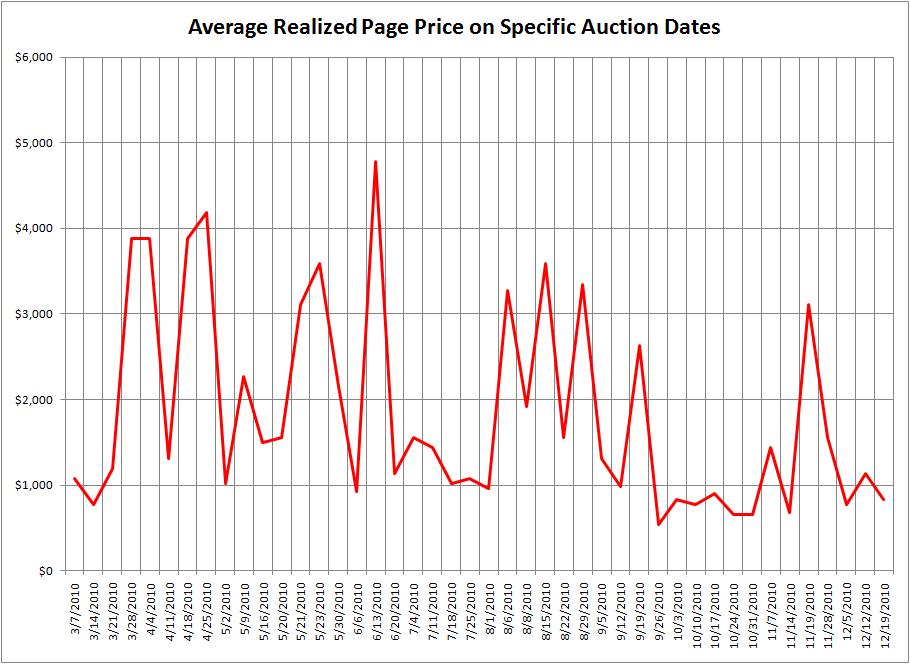
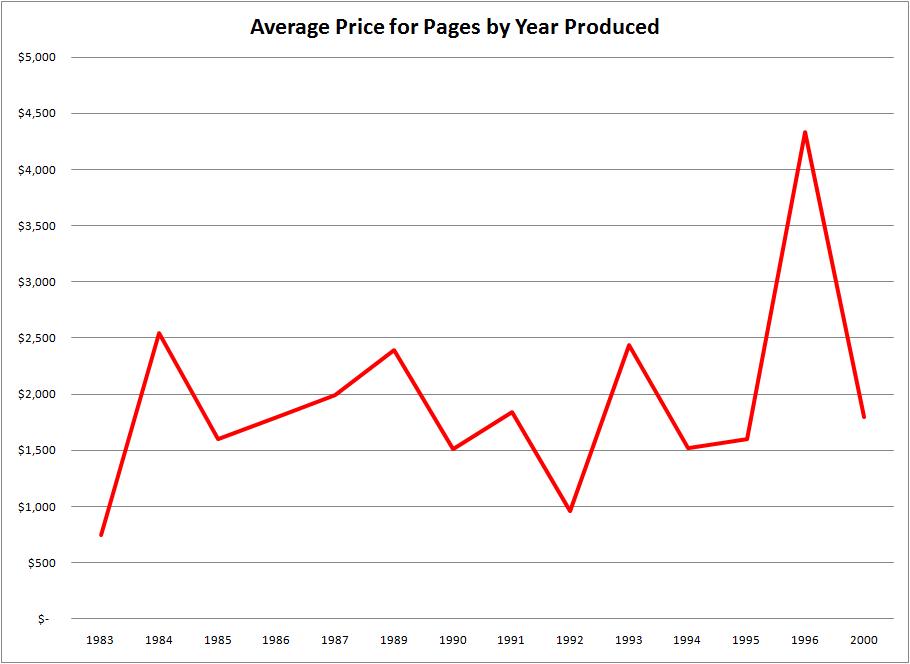
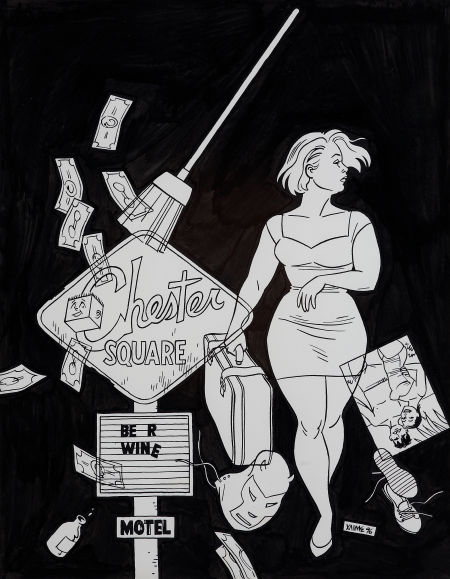
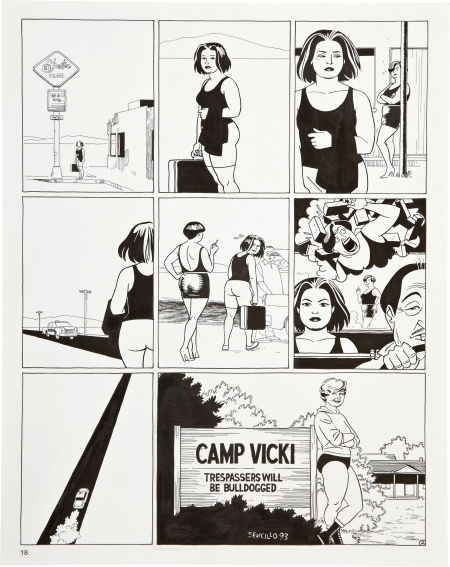
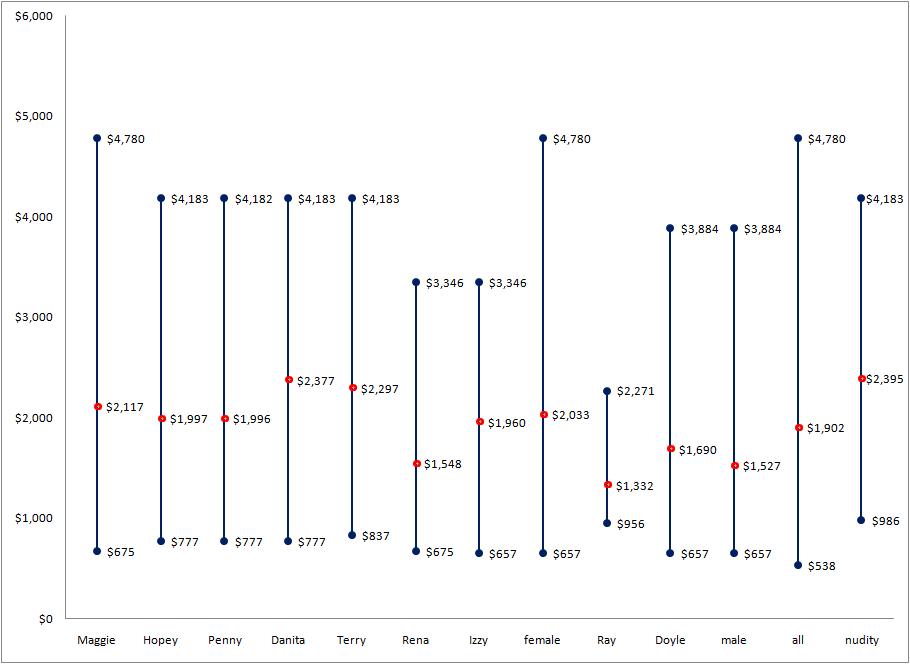
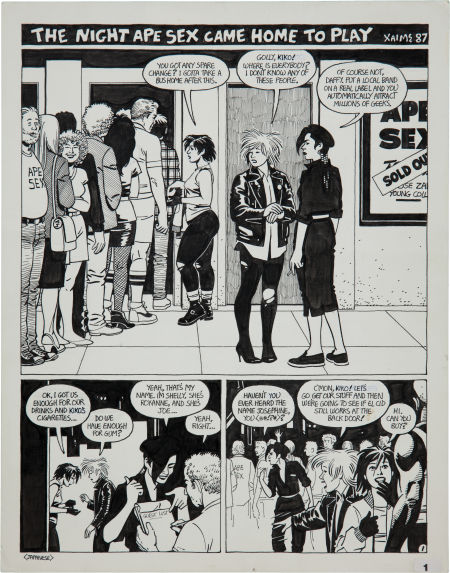
Hey Robert,
Interesting article. If you haven’t checked out cerebusart.blogspot.com, you might find it useful. Brian, the blogger on the site, tracks prices for Cerebus original art and has been doing so for a couple of years, and has periodically had up some interesting pieces of analysis that attempt to get at the bottom of individual price fluctuations. One of his primary theories is that the market is small enough for most comic artists that it can be influenced by a few buyers, and that these buyers themselves are heavily influenced by other intangibles- “grail pages” that are historically or emotionally significant for that particular person. It would be hard to quantify that kind of individual lust…
Robert: I don’t think I’ve seen this kind of detailed statistical analysis done on L&R OA in a public forum ever. Both you and Robert Boyd have indicated that “steady availability” can lead to higher art prices but there’s also anecdotal evidence that collectors can also procrastinate when such a steady supply is available, holding out for the “perfect” piece. I can’t be sure if what holds true for the fine art world also holds true for the much lower priced comics OA market.
Prices: A lot of the factors you’ve mentioned seem to figure into the mix – Maggie and Hopey, ladies not men, particularly famous storylines (I’m willing to bet that a good Death of Speedy page which hasn’t appeared as yet (I think) would sell for a premium). my guess is that the page which is being put up on January 9th on Heritage will sell for +/-$1000. I’m surprised at the lack of variation when it comes to year of publication according your analysis though. Also, I would say that the Chester Square cover didn’t sell for as much as it could have (collectors have a strong preference for covers and splashes though this applies mainly to superhero/mainstream art) because it’s not one of Jaime’s most attractive covers.
The first few weeks of the regular auction schedule would not have been representative of the whole. The sudden appearance of Jaime Hernandez art on Heritage would have caught some people by surprise (so low prices initially) which would have then been followed by a mild feeding frenzy due to the uncertainty of supply. It’s important to note that Jaime no longer sells art directly and I don’t think I’ve seen much art from the new millennium anywhere.
At this point of time, I think the “best” gauge for what the final price might be would be the “gut” of a seasoned collector who is interested in the market and who has been observing it and the art closely. One could also sound out opinions from like-minded individuals (this happens all the time but price of art of greater rarity is harder to predict). You can normally predict where the price will land up for these weekly/biweekly L&R pieces based on what the bidding is like on the first 2-3 days. Very few serious bidders will bid early on a piece they want. The Love and Rockets #24 page was never going to sell for less than $2000. How do I know? Because if it had remained in the low 1000s on the final day of bidding I would have put in a bid in the final minutes and I’ve come to realize that my bidding habits tend to be on the low side.
I say this even though Jaime’s inking on this particular page isn’t as slick as on some of his later pieces (it also has an unusual amount of corrections in it). It still comes from a reasonably well known story, has a young Maggie and is a half page splash. I’ve spoken to one collector who expressed little surprise at the final price in view of the fact that he would have been willing to pay that amount as well (and he’s not one of those crazy big spenders).
Sean is right that art collecting can be irrational but certain trends can be detected once the supply is so steady.
Oops, please disregard that messed up second sentence…and other things which you pick up.
The emphasis on characters, covers and splashes is indentical to the preoccuptions of mainstream fans…absurd but helpful to those of us who cvalue comic art for the main propertty of comics,storytelling. So maybe I could get that Doyle page cheap.
Also, hopefully alt comic art dealing has a concern with verified provenance, something that is, as far as I can see, nearly nonexistent in the mainstream original art market.
I tried to reply earlier, but just as I was writing, my house lost power. I think my reply got lost. So, one more go…
Sean: I think you are right. If the total number of bidders is small, the idiosyncracies of any given bidder can affect the prices a lot. (Particularly when your dataset consists of only 48 items.) In addition to the reasons you list, I would suggest that there are circumstances that are utterly irrelevant to the art in question that affect price. For instance, if a bidder has just gotten a big bonus from his employer, he might be willing to bid higher than usual. No model could ever capture that.
Ng: I disagree with this statement–“Very few serious bidders will bid early on a piece they want.” Because of the way Heritage is set up, you can enter a bid for the maximum you are willing to pay for a given piece without signaling to your fellow bidders that that price is the price to beat. For example, let’s say you are willing to pay $3000. The current bid is $1000. You enter your $3000 bid electronically. But the bid goes up to $1100 on the Heritage site. In other words, it remembers your $3000 bid, but only uses the minimum it needs for your bid to be the high bid. So no other bidder knows what your maximum price is–unless the bidding gets up to $3000.
James: I agree that this stuff-characters, cover art, nudity–shouldn’t be important. But I wasn’t trying to determine how Jaime Hernandez art should be priced, but rather how it is priced. And since historically, certain characters have been very popular in Jaime’s work, I hypothesized that they might affect prices. That said, the results based on the data are obviously ambiguous–no conclusion can be drawn whether “Maggie” increases the price of a page on average. But I couldn’t know that until I collected the data and analyzed it.
And while provenance is important, for items costing between $500 and $4800, provenance is not going to be a big determiner of value. (If the market is flooded with counterfeit Jaime Hernandez pages, that situation could change.)
What I think should be the determiners of price are the quality of the piece in question and its importance within Jaime’s oeuvre. But those are subjective values and not ones I can easily put into a database, such as the one I created for this piece. And perhaps that is merely another demonstration of the futility of trying to do a data-based statistical analysis of auction prices–values are often determined by subjective responses which cannot be reduced to data. That’s why we call it art.
Good work, Robert.
Yes, it seems counter-intuitive that a dealer shouldn’t encourage scarcity; but there are market situations that justify a (relative)abundance of product.
1) When a market is small and shallow. It’ll be in the interest of the dealers to expand the circle of collectors, even at the risk of short-term losses. More collectors = more bidders.
2) When turnover is important. This is a big trap for art and antique dealers: to be stuck for years with unsold, expensive inventory in hope of a big score down the line. Get the stuff out there and sell it off now, later you can cry all the way to the bank.
3) Greater fungibility. A larger market improves the possibility of turning an asset into cash quickly.
4)Network effects…this isn’t obviously applicable to art collecting, but patience.
When there are two billion telephones installed, the value of each phone is immeasurably higher than when only two hundred phones are installed. Similarly, when a thousand people own a cartoonist’s artpiece, its value is higher than when only fifty do.
It’s a fine line for dealers. Flood the market and prices will drop.
The scarcity rule does work sometimes. I was surprised to see the relatively high price attached to some Joe Staton pages; he’s an excellent cartoonist, but not a fan favorite. Turns out Staton keeps almost all of his artwork, and as he’s raely inked by others little of his work comes onto the market…mind you, this was 30 years ago…things may have changed.
Oh, man. I thought we were going to have a real true crimes expose here! Still, despite the lack of mug shots and smoking guns, an excellent piece of research
Alex, thanks for your thoughts. I think in point 3, you might want to substitute “liquidity” for “fungibility”. Art is, by its nature, not fungible (the way a share of stock or a barrel of oil is). There is a relationship between fungibility and liquidity–it is easier to find a market price (and therefore a buyer) for a product that is the exact same as a bunch of others.
Now if you are saying that by selling a Jaime page every week, Heritage is giving Jaime’s work the appearance of regular market pricing, which makes the work at least semi-fungible, I’d agree to an extent. But the fact that the prices vary so much suggests that effect is not very strong. The bottom line is that these pages aren’t good substitutes for one another, and the price of one page is not a good guide to what the price of another page will be.
And the thing is, we don’t know if there is a larger market. We can hypothesize that there might be because as a new Jaime page comes on the market for sale every week, word of mouth might get out and new collectors might enter the market. But at the same time, older collectors might have finally gotten the Jaime page they want and have left the market. Who knows? So we just don’t know if this strategy has increased the size of the market. (We don’t, but Todd Hignite does.) All that said, I don’t think the Jaime market has increased because of the “steady release” strategy. I say this because i think if it had, we’d see more of a price increase due to greater demand.
On point 4, I’m not sure how having a large number of collectors creates a network effect. A network effect works great with railroads, highways and telephones–the beneficial effect of places or individuals being connected makes the means for connecting them more valuable. But I don’t see how this applies to collectors. I think what you’re talking about is pure supply and demand. More collectors means more demand which means higher prices. But again, it’s not clear that there is, in fact, growing demand here. To know this, I think we’d want to look at the number of unique bidders for every auction and see if it has trended higher over time. This information would be in the possession of Heritage, and if I had thought about it, I would have asked them for it.
Pingback: Adventures of Ray » Why I Hate Batman 1: The Saboteur
Robert: It’s true about how the Heritage auction system works but the psychology is still quite similar to what happens on eBay. People don’t want to pay the maximum (the work isn’t rare enough for that). So, while I don’t know for sure, I think sniping is still prevalent. The potential buyers might still be figuring out their maximum bids 10 minutes before the auction’s close depending on where the price is at. Keeping the price low by not entering an early high bid (which might trigger the high bid of a competitor) seems to be part of the psychology of such online auctions. My impression is that this kind of behavior is even more prevalent at the Heritage Signature ‘Live’ auctions where the serious bidders won’t show their hands until the live bidding.
I’m with you in your impression that the Jaime Hernandez art market has not increased (at least not due to the auctions). If interest in his OA is to increase, it will be through his latest publications. I might be wrong but I think that L&R has lost a lot of customers since its heyday even if the work is stronger than ever (and is in fact the art I’m most interested in). I think Gilbert Hernandez’s more recent art doesn’t sell for as much as a piece from Heartbreak Soup or Human Diastrophism (which might partially reflect the reduction in readership). I’m curious what Jaime’s more recent art would sell for.
Alex: Interesting points, gleaned perhaps from your years at that French auction house? Joe Staton prices don’t seem particularly high to me. Not that I’m paying close attention mind you. I think a better example of this might be art by Walt Simonson.
my grandfather sold an original R. Crumb for $7000 on ebay just before he died
Suat: at the time (1978) it wasn’t an auction house, but a gallery…
Robert, you’re quite right, liquidity, not fungibility, was the word I should’ve used. Not being an interchangeable commodity like a bushel of wheat or a dollar bill, OA has very low fungibility.
I was confusing in my use of “network effect”…what I meant is that this effect works for buyers and sellers who use the auction process; obviously, the more of each, the more the other side of the transaction benefits; this increases the overall value of the middleman.
“this increases the overall value of the middleman.” True, but only if certain conditions exist. The middleman has to add value. Otherwise, why not use eBay?
What value does Heritage add? I hope that they, as James suggests above, would help to guarantee provenance. They also have consultants on staff who help consigners get the most from their auctions. And they are recognized by buyers and sellers as a place to go for specific types of goods. However, large numbers of buyers and sellers doesn’t guarantee big profits for the middleman. The history of the stock exchange shows this–while it was a cartel, being a stock broker was a really lucrative profession. Once the cartel was broken up, the price of a stock transaction (and the incomes of individual brokers)plummeted.
The only reason that Heritage (and Sotheby’s and Christie’s)can compete with eBay is the value added–their expertise, primarily.
Agreed!
However, the value of the middleman company doesn’t depend on its margins alone. I mean, e-Bay proved that pretty decisively, didn’t it?
But I agree that a fairly specialised house like Heritage can make a difference by the quality of its service and reputation alone.
Oh– and stockbrokers still do O.K., you know?
Ebay is successful on volume, just as discount brokerages like Scottrade are. A successful stock broker today is not just someone who executes a trade, but is someone who is an adviser. They add value above and beyond just executing orders. For an auction-house to make more per trade than eBay does, they have to offer some added value. Ditto a broker who wants to make more per trade than Scottrade does. There is a reason that as fixed commission rates were abolished that he number of CFAs skyrocketed. (Sorry to get off topic…)
Well, cheapness and volume can lead to riches…as Henry Ford showed.
But overall, Robert, I really do agree with you.
However, auction houses do have other options to attract sellers…look at Sotheby’s and Christies’ guarantees.
A dangerous road to go down, though.
Alex: For sure–that’s why eBay and Scottrade and eTrade are big, successful companies. And guaranteed minimums is a perfect (if extreme) example of value added that a basic discount auction house like eBay would never do.
Pingback: Tweets that mention Jaime Hernandez for Sale « The Hooded Utilitarian -- Topsy.com